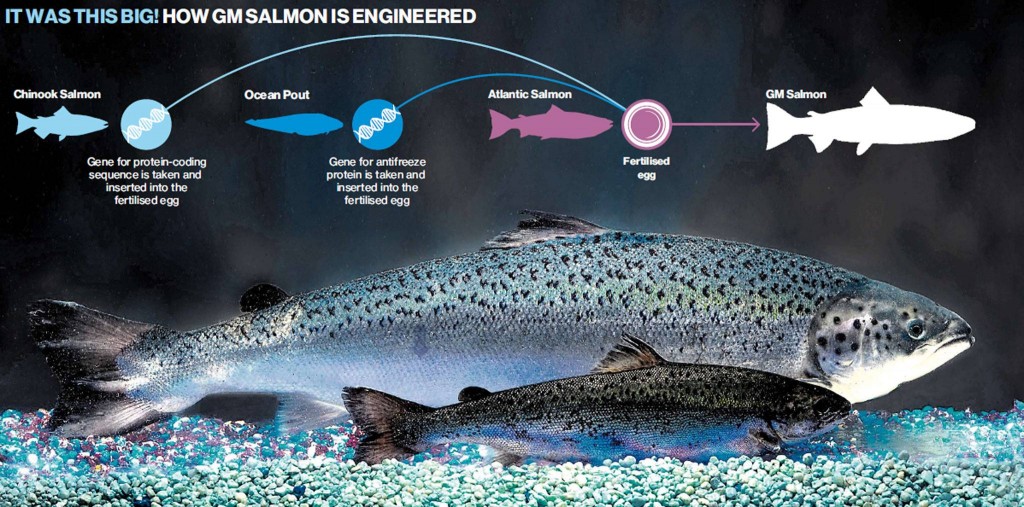FDA Approves New Animal Drug Application for GMO Salmon
 Last week, the Food and Drug Administration approved a supplemental New Animal Drug Application (NADA) submitted by AquaBounty Technologies, Inc. While the original application was approved in 2015, this current application grants AquaBounty Technologies, Inc. the right to raise a GMO salmon species it has developed called AquAdvantage salmon at their farming facility near Albany, Indiana. The facility uses growth tanks rather than ocean pens and will be able to grow 1,200 tons of GMO salmon per year. The facility was designed so it can be expanded quickly to meet higher levels of demand for the new product.
Last week, the Food and Drug Administration approved a supplemental New Animal Drug Application (NADA) submitted by AquaBounty Technologies, Inc. While the original application was approved in 2015, this current application grants AquaBounty Technologies, Inc. the right to raise a GMO salmon species it has developed called AquAdvantage salmon at their farming facility near Albany, Indiana. The facility uses growth tanks rather than ocean pens and will be able to grow 1,200 tons of GMO salmon per year. The facility was designed so it can be expanded quickly to meet higher levels of demand for the new product.
As soon as the FDA and Department of Agriculture agree on guidelines for consumer labeling of the genetically engineered AquAdvantage salmon, the company will be allowed to import the genetically modified eggs from their facilities in Canada and Panama, where the company currently genetically engineers its eggs. The eggs will then be grown and sold in the U.S. market.
According to an FDA report, AquAdvantage salmon is a genetically-engineered fish that can reach market growth more rapidly than nonmodified farm-raised Atlantic salmon. The fish are able to grow quickly because they contain DNA composed of the growth hormone gene found in Chinook salmon under the control of a gene from another species of fish called an Ocean Pout, which keeps the Chinook growth hormone gene switched on. This creates a fish that can grow to market weight in 18- to 20-months vs. the 28- to 36-month period it takes to grow farm-raised Atlantic salmon. Wild salmon growth rates vary widely depending on the species.
Environmental groups, commercial fishermen, and “eat wild” advocates are heavily opposed to this expansion of genetically-engineered salmon stocks. These groups continue to voice their concerns over crossbreeding, food safety, potential damage to wild habitats, and the spread of disease and pests to wild fish stocks. A recent pen collapse in Washington State led to a ban on all new Atlantic salmon farming in the state and a ruling that will phase out all net pen farming by 2025 as leases expire. There are currently only 10 such facilities left in Washington State. Net pen farming is banned in Alaska and Oregon. In 2016, a provision that requires labeling for all genetically-engineered salmon sold in the U.S. was included in the Omnibus Appropriations Act. Alaska Senator Lisa Murkowski was instrumental in the formation of this requirement, which states:
“The FDA may not allow the introduction or delivery for introduction into interstate commerce, any food that contains genetically engineered salmon, until final labeling guidelines for informing consumers of such content are published.”
After this success, Congress was able to pass the National Bioengineered Food Disclosure Law, which requires the U.S. Department of Agriculture to develop regulations for labeling food derived from bioengineered sources. Those labeling guidelines have not yet been established; however, with the approval of the growing facility in Indiana, it won’t be long.
“With the facility now approved, commercial production of AquAdvantage salmon awaits only official labeling guideline by the FDA,” AquaBounty Technologies announced in a press release.
Many scientists have voiced concerns about this fast-growing species getting loose and competing with wild fish for resources. There is also concern regarding crossbreeding with wild stocks. While the AquAdvantage salmon are modified to be sterile, biologists agree that this is not foolproof.
You Are What You Eat
Putting the genetic modification debate aside, fish flesh really is only as healthy as what the fish eats. Wild salmon are full of the rich long chain omega-3 fatty acids that scientists have discovered are extremely good for human health. Wild salmon eat other fish, mollusks, krill, and planktonic crustacea that are rich in Astaxanthin, a naturally occurring pigment that is responsible for the pink flesh of salmon, lobster,and prawns. It is also thought to be a powerful antioxidant.
Farm raised salmon are fed a diet of pellets that are produced from by-products of other animals (made from dry, ground, rendered parts of the carcasses of chicken and other fish), plants (such as corn, soy or wheat), and canola oil. Many of these fish-farm pellets are produced in South America and shipped to countries like the U.S. and Canada.
Some experts argue that we may be diverting protein sources away from humans who need it to grow greater quantities of fish more cheaply. On the other hand, the world needs inexpensive protein sources to feed its people.
Our team will keep you up-to-date on this debate and the new labeling laws as news becomes available.
 Maritime Injury Law Blog
Maritime Injury Law Blog

